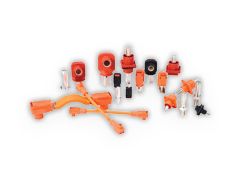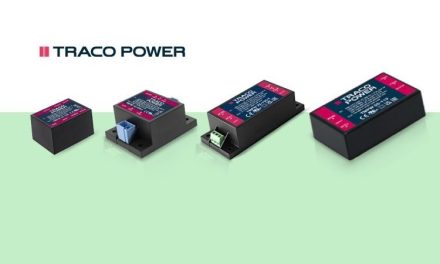 Nick Harper at ODU-UK explores how shrinking device geometries are enabling soldiers to be deployed out into the battlefield with increasingly sophisticated personal equipment and how this is leading to the future of the fully connected interface, reinforcing communication and defence paths
Nick Harper at ODU-UK explores how shrinking device geometries are enabling soldiers to be deployed out into the battlefield with increasingly sophisticated personal equipment and how this is leading to the future of the fully connected interface, reinforcing communication and defence paths
Not much has changed for the infantryman since the 60’s – they continue to sketch battle plans on paper maps and they are still too vulnerable to enemy fire when they step out of their helicopters or AFV’s. The worlds’ armies have spent billions on various forms of ‘taxi’ to get the soldiers into battle, but comparatively little on the individual soldier (except perhaps new boots).
Now, we’re fighting a different kind of war. The Iraq conflict has been described as a ‘commuter war’ with AFV’s taking troops right up to the front-line, but in Afghanistan the problem is pack-weight, with the foot-soldier expected to carry everything he needs for three days or more. Even those technical gains that have been made, come at a price. For instance, today’s infantrymen have a clear advantage when fighting at night, thanks to advanced sensors – but there’s no gain during the day – and they still have to carry the extra weight.
Wearable infantry devices Soldiers have become like Christmas trees, with more and more kit hanging on them. On average, a soldier must now carry 47kg, with a vest weight of around 12kg, so clearly weight has become a major issue. As technology becomes available, the number of interfaces increases – but each piece of kit needs to be removable and replaceable, often at speed, whilst under fire. At the same time, more protection is rightly demanded – so as body armour increases, less space is available and the design conundrum continues, with weight (and power) the ‘Achilles’ heel’ for the equipment manufacturers and foot-soldier alike.
According to military strategists, the ideal would be to make each soldier a ‘net zero’ entity – self-generating his own power on the battlefield, whilst operating from a self-sustaining set of vehicles capable of generating their own fuel and water whilst carrying munitions for about a month – but that’s a long way off. Meanwhile, there has been, over the last few years, some rapid development in the arena of battlefield communications, especially for the foot-soldier. The many ‘Future Soldier’ and ‘Dismounted Soldier’ programs around the world have been fully tested, revised and tested again. However, during the whole of this process, the key drivers for all of the equipment manufacturers have remained consistent and on-going:
- Weight reduction
- Robustness
- Easy handling and cleaning
- Safe multi-signal transmission…
and all of the above are required to fit the smallest possible space. It’s all about getting the important tactical information right down to each individual soldier.
Today, the squad-leader is already connected to headquarters and the networks, but the squaddie still probably relies on shouts and hand-signals. But information is increasingly important for everyone. Where am I? Where are my friends? Where are the bad guys? Has the plan changed? The good news is that soon, every soldier will be able to be connected to all the information he needs.
One of the first Future Soldier programs to have been fully developed and actually deployed is Gladius – used by German infantry units, with each Gladius system covering a ten-man infantry unit and it’s vehicle. Its introduction is a major step forward for the Bundeswehr, which will significantly improve overall operational effectiveness, while simultaneously enhancing the survivability of individual soldiers.
ODU’s customer Rheinmetall, formally handed-over the first thirty Gladius systems in March this year, for training prior to the deployment of the first contingent of three hundred infantry soldiers to Afghanistan this summer.
Rheinmetall won a development contract in 2006 and after successful trials received an initial production order in 2012 for the first thirty systems. Now a further sixty systems (value €84m) are due for delivery in two stages this year, so as to equip the next two contingents deploying to Afghanistan. Developed by Rheinmetall under the ‘Infanterist der Zukunft (IdZ 2)’ program, Gladius is one of the most advanced systems of its kind anywhere in the world.
Each system takes full account of the complex operational requirements levied on modern soldiers and is intended to bring each member of a ten-man infantry section, and its vehicle, into the network-enabled operational loop. This network, consisting of reconnaissance, command and control components and weapons, enables rapid exchange of information, as well as shared situational awareness, as the basis for planning and conducting operations. A soldier wearing this system receives all relevant data concerning the tactical situation, the position of friendly forces, the mission, and system status. During testing and development, Rheinmetall has refined the system’s ergonomic features by reducing its weight, shrinking its components and improving the overall integration of those components.
The modular battle dress, body armour and harness system provide excellent protection from detection in the visual and infrared spectrum as well as from the weather, even in extreme climate zones, and from biological and chemical agents. Flame-retardation and vector protection is included in the system’s high level of protection – with an ‘electronic backbone’ that contains the radio, core computer, batteries and GPS module.
“Gladius gives the Bundeswehr one of the world’s most advanced soldier-systems. ODU-UK are proud to have played their part by providing connector development”, comments Nick Harper. MD at ODU-UK. The Gladius system needed dependable and highly-flexible interface solutions for the electronics and energy supply to connect personal equipment, optics, optoelectronics, and communication devices – all this, in the form of efficient and secure ‘wiring’, with connectors that are quick and easy to open and close with totally reliable locking.
“We have been able to solve many taxing demands and application problems for our customers with our ODU AMC Advanced Military Connector Series, which has been very well received in the market.
“Our customer feedback is consistently very positive and has also enabled us to be established as part of the next generation of research and development projects”, said Harper. However, one thing that the company did learn from its work on various Future Soldier programs, was that the biggest concern of the foot-soldier was “can I clean it?”
It was this feed-back about the ability, during conflict, to swap and clean equipment that gave rise to the latest development in the company’s AMC connector range: ODU-UK AMC Easy-Clean, offering:
- Fast and Easy Cleaning Guaranteed
- Remove mud, slop or dust quick as a flash
- For clean contacts and safe data transmission a major step in the process of improving the equipment of infantry forces in future deployed operations, thus enhancing the survivability of the individual soldier
- Extremely robust and stable
- Light weight – small dimensions
- Simple to use blind-mating
- Can be used under the toughest conditions
- Excellent 3600 shielding properties
- Operating temperature -510C to +125 °C
- Flexible coding options – mechanical and colour
- Watertight to IP68
- Lifetime up to 5,000 mating cycles, dependant on specific application system solutions, including wiring, packaging and encapsulation
The company’s military expertise is predominantly in the design and manufacture of rugged, miniature ‘push-pull’ and ‘snatch’ connectors, being a long-term supplier to the likes of Thales, Selex, Oerlikon, Saft and General Dynamics in applications such as helmet- connectors, night-vision systems, radio and radar systems, portable navigation, laser-designators, AFV infra-structure etc. For instance, in the UK, the Bowman program has utilised over 100,000 helmet ‘snatch’ connectors from the company, so far without a single failure being recorded. But it would be true to say that, right now, the needs of programs, such as Gladius, are driving further developments of these connectors.
These connectors offer excellent data-transmission, 3600 shielding properties and can be waterproof. In addition, the designers have worked hard to produce connectors that are simpler, more intuitive in use, with foolproof blind-mating. At the same time, these connectors are extremely versatile – common receptacles can receive either locking or snatch plugs, depending on the equipment function and the soldiers’ needs with mechanical and colour coding.
owever, the company’s skill-set, as an independent, specialist, connector manufacturer includes a special ingredient – flexibility – the ability to sit down with the customer and design a way out of a problem, the ability to produce a connector that is truly fit-for-purpose and the ability to deliver that connector on time and within budget. In battlefield deployment, the soldier deserves a connector system that is totally secure and utterly reliable – that is exactly what the company aims to offer. To serve the various soldier -modernisation systems is only the start – ODU’s target for the future is to connect all interfaces around the soldier, such as weapons, communications systems and vehicle connections using the company’s AMC connectors, so that system engineers and soldiers can benefit from one connector family that meets all requirements for their specific applications.
ODU-UK
www.odu-uk.co.uk



